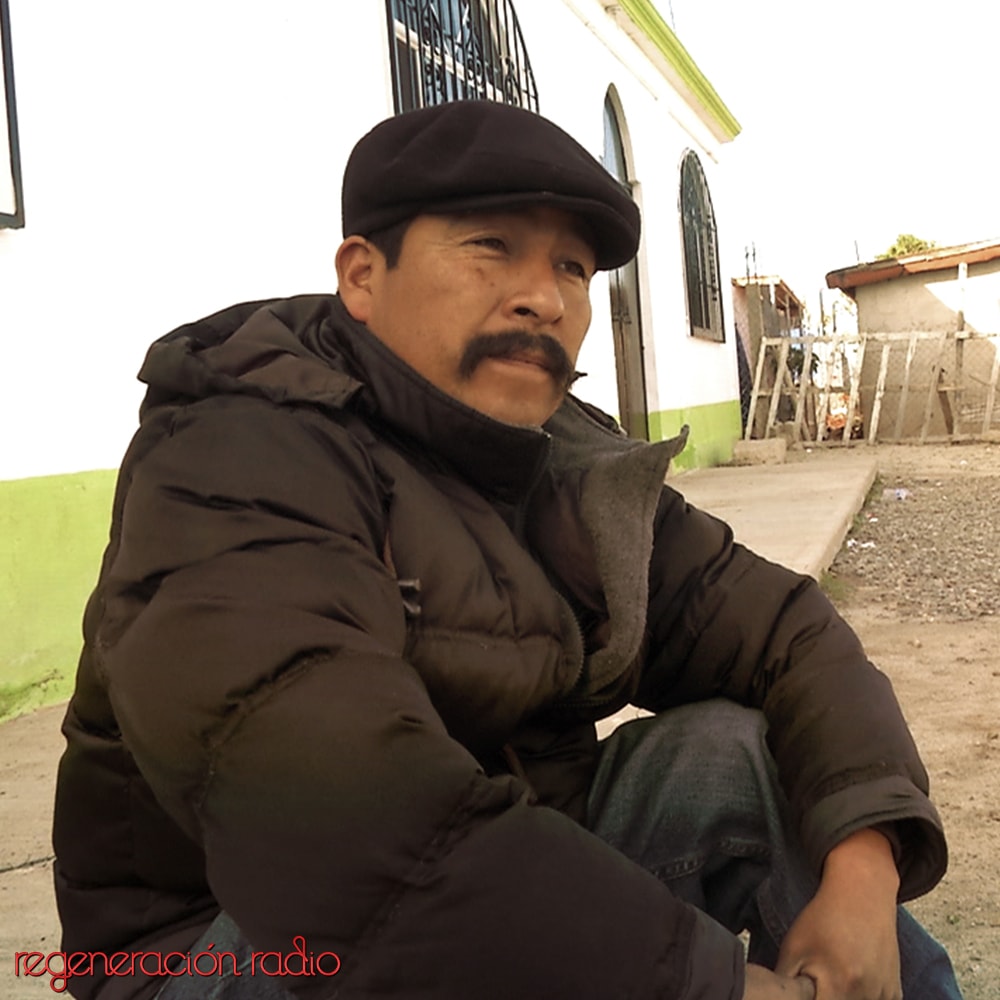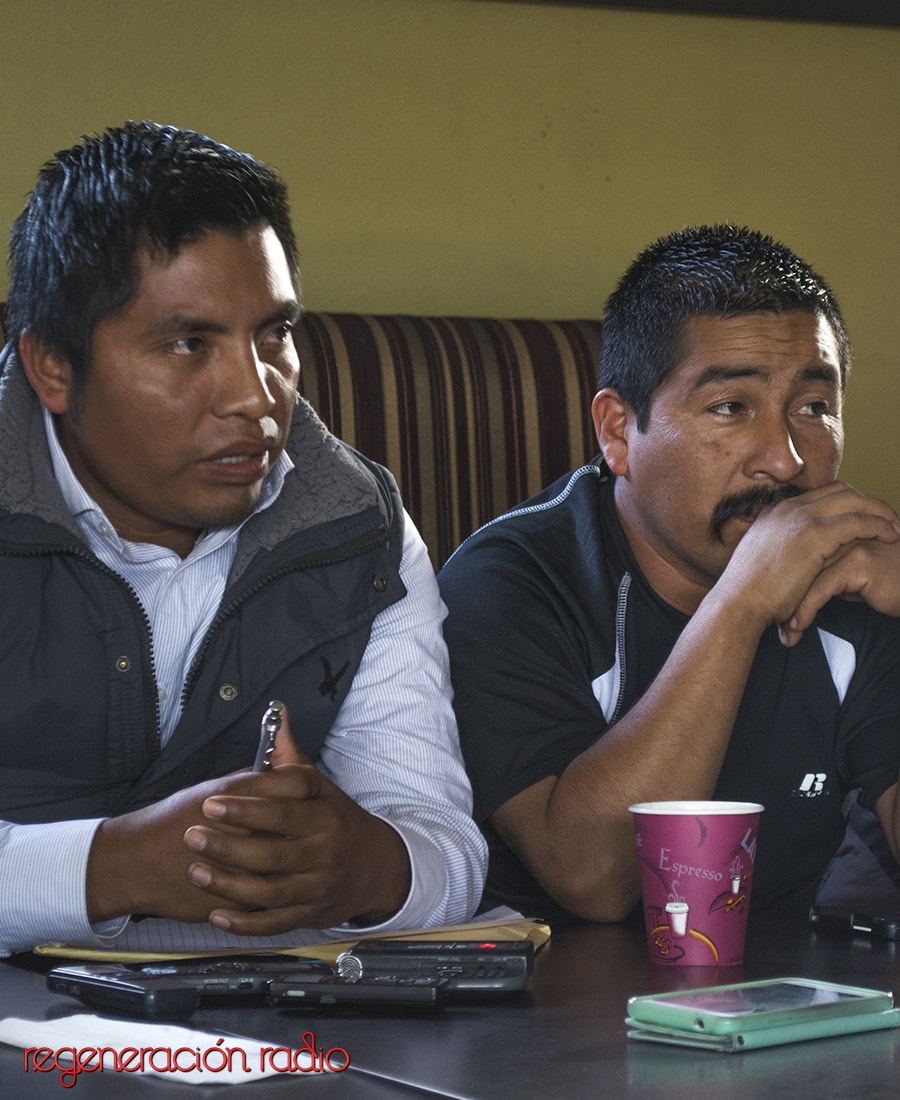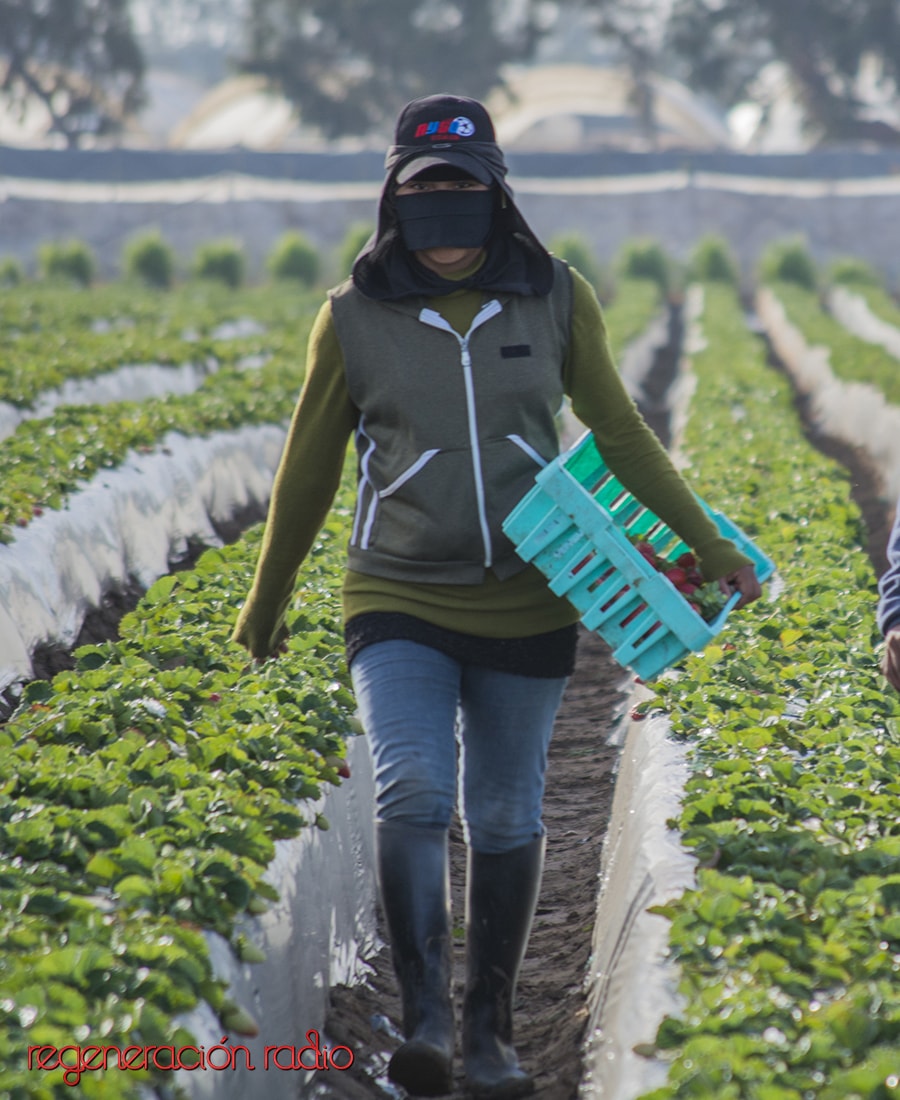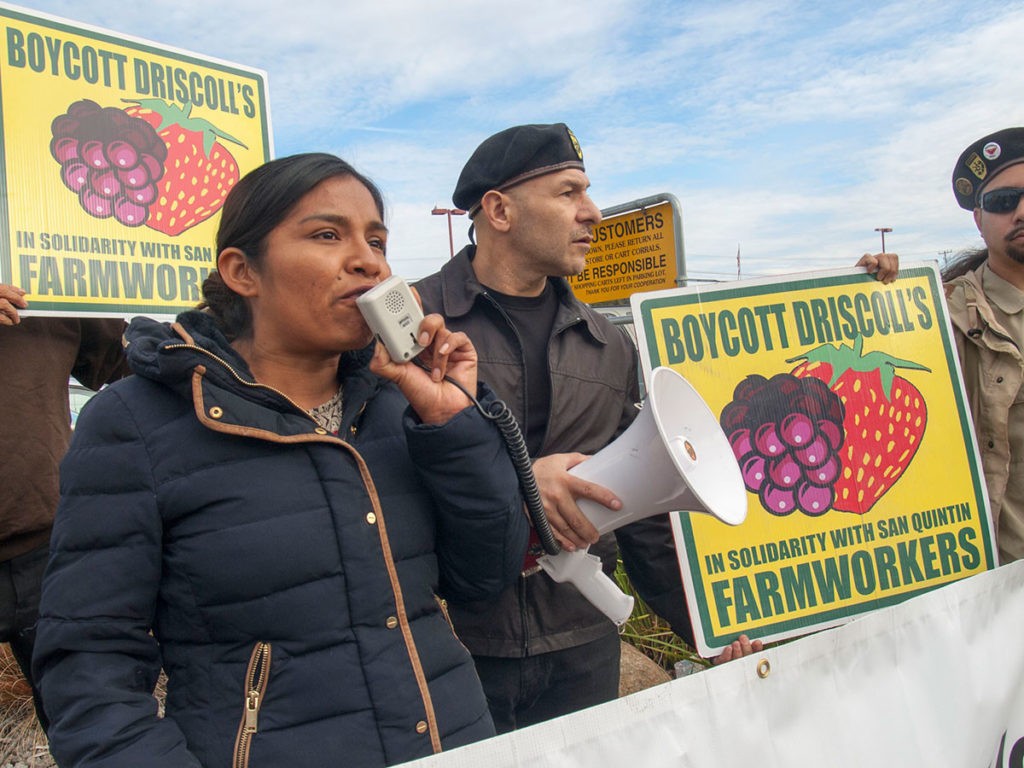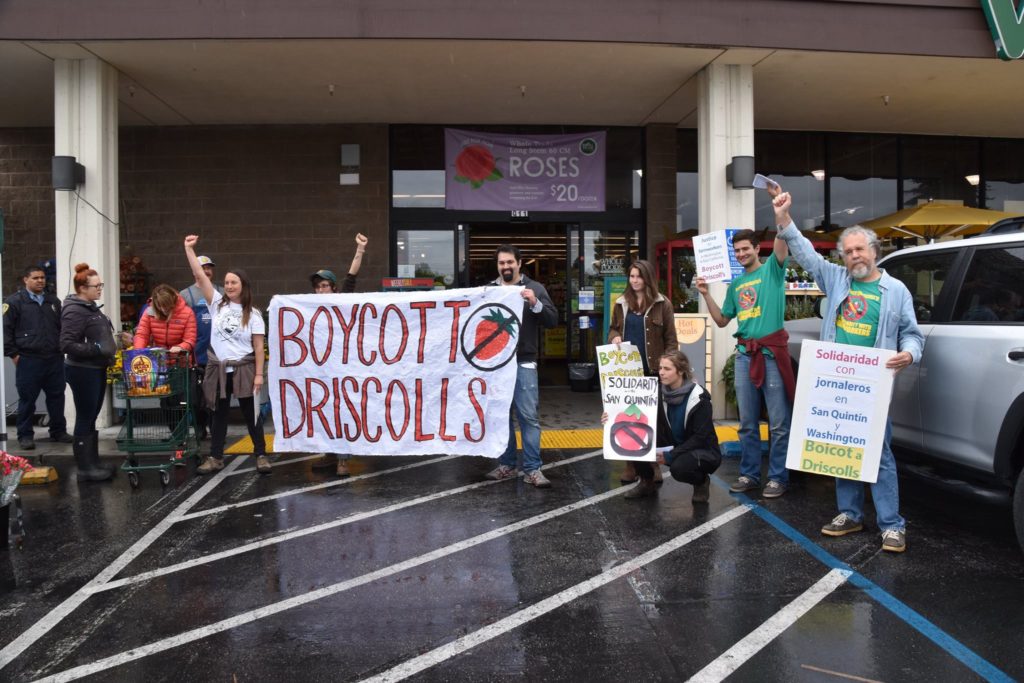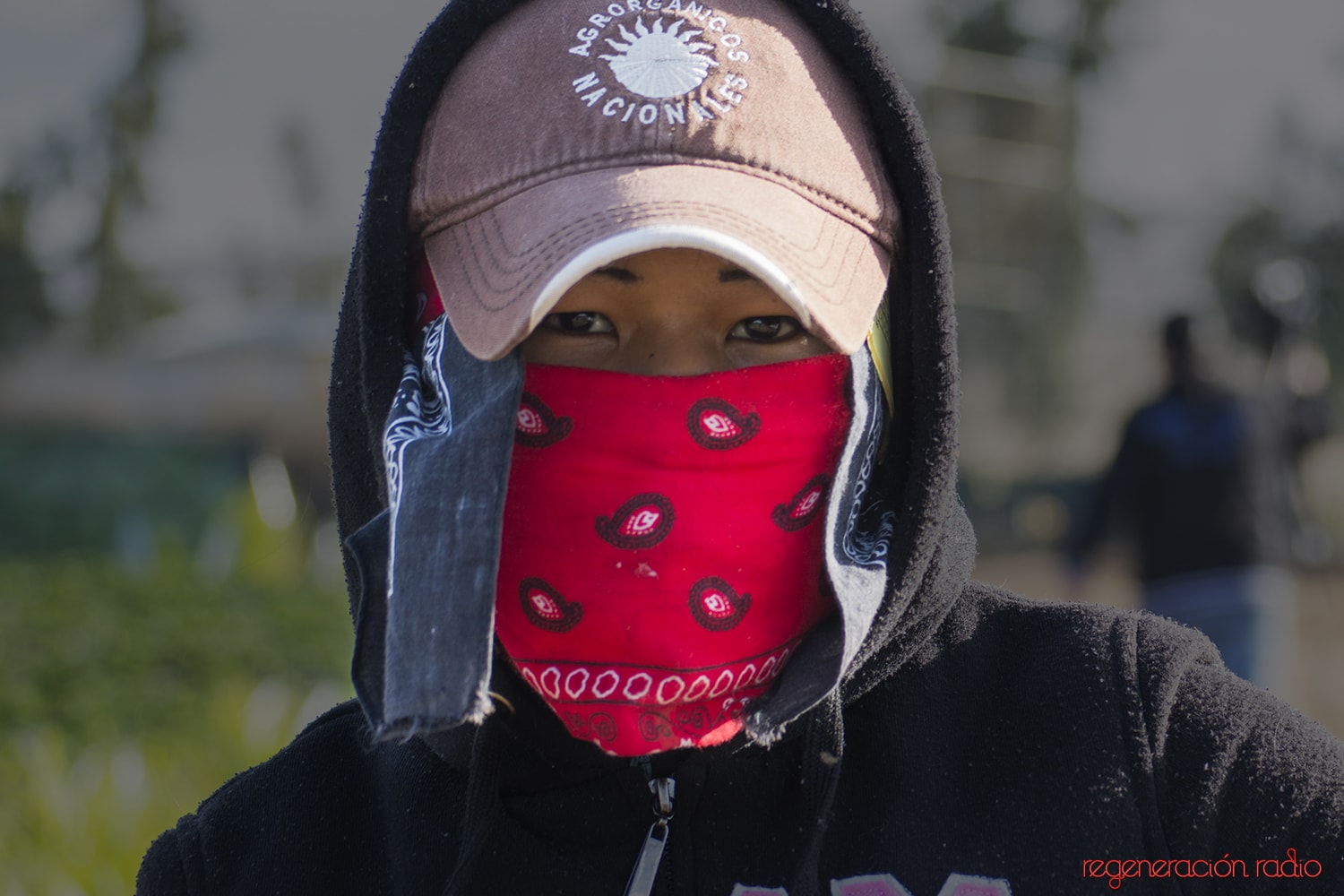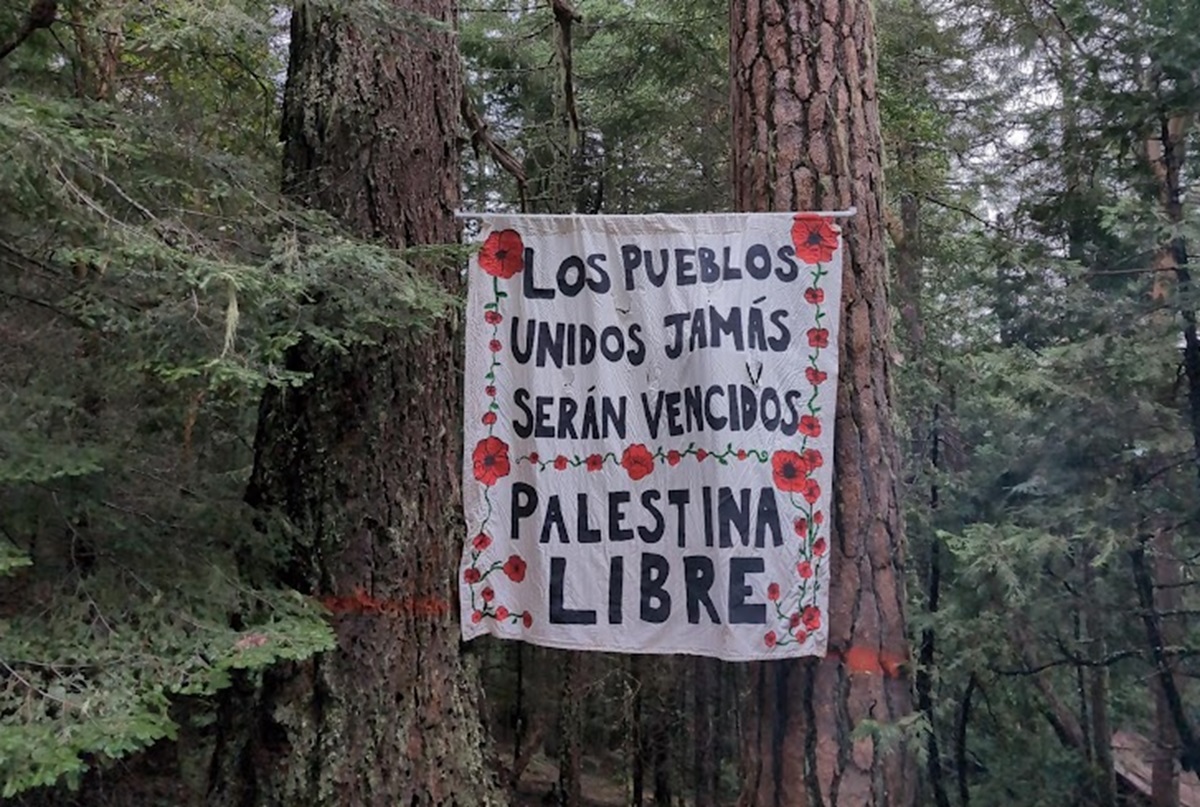Filed under: Documentary, Indigenous, Labor, Mexico, US, Video, White Supremacy
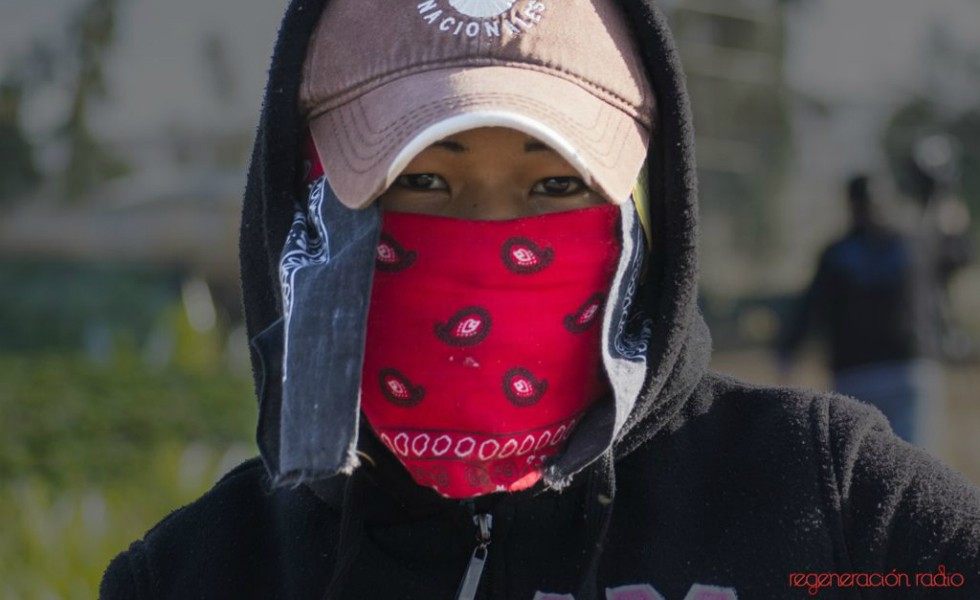
From Regeneración Radio
IGD encourages you to view the Original Microsite
I. THEY SAID WE WERE CRAZY
The strawberry harvest was approaching and thousands of farmworkers were preparing to shut down the Transpeninsular Highway on March 17, 2015. There was no turning back. Two years earlier, a slogan had spread like a dust cloud throughout all of San Quintín Valley: fair wages. And between the rows, there where celery, squash, greens, chile, beet, cucumber, tomato, strawberry, blackberry and raspberry are planted to be sent to the other side of the border, there was already talk of a “crazy idea”: they had to rise up. On a clear morning, in a barren spot some fifty meters from his home in the San Juan Copala neighborhood, Bonifacio Martínez recalls the moment that started it all:
– “One afternoon I came home from work, tired. And I saw my mother. She told me she had worked all week and that they hadn’t paid her. So we went to the boss who told her to wait a week. That got me really angry. Imagine, you supposedly work to get paid, because you’re doing the work. And this is what I thought: What kind of bosses do we have? If as it is they are paying us so little, where are we going to end up? Where are our rights?”
Bonifacio is around 40. He is no taller than 1.6 meters (5′ 3”), wears a black jacket and a cap covers his hair, he’s Oaxacan Triqui through and through. Two kilometers from where he stands, the waves of the Pacific Ocean break on the brown beach, and opposite the hill he looks from fields of strawberries spread as far as the eye can see. Nearby, a dozen bundled-up farmworkers with their faces covered work their shift. “In this field” – as he points to the carpet of green – “in previous years work started at 6am. You ate in less than 15 minutes, in the middle you grabbed lunch, some tacos, and went until 6pm without stopping. Be careful if you rest one day, because the next you won’t have a job. It’s Felipe Ruíz Conrado’s business. He paid 9.50 pesos a box.”
Before the uprising, Bonifacio had worked at almost all the ranches in the region. “Awful treatment from those bastards. They didn’t care what happened to you. They only cared about the quality of the fruit, that you don’t bruise it, that you don’t put in one or two bruised strawberries, because then they won’t pay you for that box. There were days when they didn’t pay you for up to ten boxes; at 10 or 12 pesos each.”
THE SEED OF DISCONTENT
FARMWORKERS IN MEXICO:
3,355,264
2,366,428
WITHOUT HEALTHCARE
50%
EARN BETWEEN 60 AND 120 PESOS DAILY
81%
WITHOUT A CONTRACT
79%
AS INFORMAL LABOR
SOURCE: INEGI, NATIONAL OCCUPATION AND EMPLOYMENT SURVEY (ENOE), FIRST TRIMESTER OF 2015
Bonifacio began to organize with two other farmworkers, Juan and Cirilo. Their objective, contrary to what had happened before – focused work stoppages on small ranches – was to organize and get the entire valley to rise up, a strip of coastal desert that reaches from the municipality of Ensenada, Baja California, and extends to the towns of Vicente Guerrero, Camalú and San Quintín, and where in addition to clamming, the ranches of companies like Driscoll’s, BerryMex and Los Pinos are the only sources of employment. A neo-slavery that has crashed onto this land.
“They told us we were crazy,” says Bonifacio with his Oaxacan accent. And from memory he recounts for the tape recorder the talk that he started to share with his neighbors. “You love your children, so what are you doing to defend them? If you love them, now is the time for us to seek a solution so they don’t live like us. Wouldn’t you like for them to pay you more? If you want something better, let’s defend this together. I don’t come offering handouts or money or loans, I don’t have these things. What I can tell you is that I am a worker, just like you, and this hurts me the same as you. What I can tell you is that I wake up at 4 in the morning, and my wife does, too, to make lunch. And I’m sure that you and your wife do as well; I’m sure that there isn’t enough for cooking gas, for the electric bill, right? Well, the time has come.”
From those talks the Alliance of National, State and Municipal Organizations for Social Justice was born, meeting every Friday. And in the ranches, in the neighborhoods, the word spread. “The supervisors, the foremen, the producers already knew, they had heard. But they said: “What can they do to us? For years we’ve beaten down those fucking Indians.”
The date was set for March 17, when the strawberry season was drawing near. That day, at dawn, nothing and no one would pass on the Transpeninsular Highway that runs from Tijuana to Cabo San Lucas in Baja California Sur. The farmworkers, thousands, would stand up as one to make themselves heard. A prophecy written centuries ago came to pass, when Jacinto Canek rebelled in the Yucatán: “The Indians have revolted!” – as the Indians from Oaxaca, Guerrero and Chiapas are the majority in San Quintín. On the night of March 16, no one in the valley slept, and at dawn the whole world knew about the farmworkers standing up in the middle of the desert in the cold and hidden north of Mexico.
II. THE UNION AND SHADY POLITICS
On the road south from Tijuana, the asphalt of the Transpeninsular opens out into long kilometers of muted landscape. Mountains, gloomy and indifferent cacti, shrubs and dangerous curves crowd together alongside the fierce and foaming sea. An architectural crucible, sometimes Arabic, other times modern, and other times humble, decorates the route and a faint silence seeps in from the outside. Inside, a station, XEQIN, the Voice of the Valley Radio, is on at low volume on the stereo. It is the only channel for kilometers. Little-used paths appear, heading towards “Wine Country.”
The road snakes forward and up ahead, on the icy sea, a group of cruise ships, white like the purest milk, sit in front of Ensenada, the last large city on the Peninsula before La Paz. Up ahead, in Vicente Guerrero, when the car stops, night spills over the valley and it will be time to sleep at 16 degrees centigrade (61°F). A deep cold.
The following day, January 13, in Ensenada, the cruise ships are still there. In the Zu Taza café, some 30 meters from the beach, the spokespeople for the farmworkers of San Quintín are seated around a large table. They outline for the local media an evaluation of the movement after almost a year of blockades, marches, caravans, boycotts and meetings. On May 13, 2015, after almost two months of rebellion, the Alliance and the federal government signed agreements establishing some ways of resolving the conflict. Government healthcare, punctual pay, certification that companies don’t use child labor – in the fields women, children and men work – respect for labor and human rights, and an increase in wages. “San Quintín decided to sneak away under the table…none of the issues have been resolved…we want to recoup the benefits that have been taken from us,” said Fidel Sánchez Gabriel.
THE DAILY LABOR OF AN AGRICULTURAL WORKER IN THE RED
The agreement reached in August 2015 with the owners of the more than 122 companies that grow in the San Quintín Valley was that they would pay a minimum wage of 150 pesos per day and that wages would be fixed in three different categories: 19 companies would pay 180 pesos per day, 39 would pay 165, and 64 would pay the minimum of 150. But in reality, few companies do and the state and federal governments have not been monitoring the implementation of the demands. In the fields, reality is different, said Lorenzo Rodríguez, an indigenous man in his twenties:
– “The categorization of salaries remains stuck on the table. And the companies that have increased wages have also increased the work. They require that you work more rows, not recognizing overtime.”
Because of this, the entire movement in the valley has turned toward the creation of an independent union. Even though it was not an initial demand, the farmworkers’ own union is the long-term wager for the movement. The press conference in the Zu Taza café is actually the formal announcement of the union, whose registration was granted one day before by the Ministry of Labor and Social Welfare (STPS). The Independent National Democratic Union of Agricultural Workers (SINDJA) has been recognized “for the purposes of advancing the legitimate representation of those farmworkers,” reads the official notice. Its general secretary is Lorenzo Rodríguez, who now takes the wheel of the car that returns to Vicente Guerrero after the press conference.
THE MOVEMENT’S DEMANDS
300 pesos
MINIMUM DAILY WAGE
30 pesos
BOX OF STRAWBERRIES
17 pesos
JAR OF BLACKBERRIES
8 pesos
BUCKET OF TOMATOES
They reached an agreement for a daily salary of 150 pesos; increased by 30 pesos, but the work doubled.
“I am from Oaxaca. I arrived in the valley in 2005 at 15 years old when I finished grade school and during the vacations I came and worked for two months. I thought then that there was money to be made and I decided to stay. I began at BerryMex. I explained to them that I went to high school in the afternoons, and they gave me a chance, but I did not do well in class and the work was very hard. So I left school. I didn’t care about anything, I didn’t see the exploitation or the humiliation or the harassment. To say nothing of the miserable wages. Before I was 17 I didn’t see a future for myself. I thought I was young and could do well in any job; that those who had to would struggle. Not me. But then I opened my eyes. What was going to happen when I was 50, 60 years old? I was not going to have the same energy. And my children?”
Lorenzo is dark skinned. His hair is gelled and today he’s dressed “formal” for the press conference. But later he must return to the fields. He is perhaps the youngest union general secretary in the country, barely 25 years old, and also the only one who, along with his union role, is a farmworker. On the road, he points out to the places that were blockaded on March 17, and where days later the caravan traveled to Mexicali, the seat of the state government headed by Francisco Vega de Lamadrid, a pure PANista [a member of the right-wing National Action Party (PAN)], who farmworkers say is the benefactor of Rancho Los Pinos, one of the biggest in the valley. The inner workings of power.
THE BEGINNING OF THE REBELLION
Rancho Los Pinos holds the National Export Award. The recognition was granted in 2013 by President Enrique Peña Nieto. The award, said the government, “is the highest honor…for companies, institutions and organizations that operate in Mexico in the realm of international trade, and thanks to factors such as effort, perseverance, creativity, quality and innovation have managed to compete, increase and diversify their sale of goods and services abroad.” Antonio Rodríguez Hernández, the current owner of the ranch founded in 1952, was a PAN state representative from 2004 to 2007. Later, until 2013 he served as Secretary of Agricultural and Livestock Development in Baja California in Governor José Guadalupe Osuna Millán’s cabinet, the PANista predecessor of Francisco Vega. A meteoric career, with mutual benefits.
The position that Rodríguez Hernández formerly held now belongs to Manuel Valladolid Seamanduras, a relative of Antonio Valladolid Rodríguez, the current Secretary of Planning and Finance. Manuel Valladolid has been identified by the farmworkers, and by local PAN representative Rosalba López Regalado, as the owner of Rancho Valladolid, according to information gathered by the weekly publication Zeta, from Tijuana, on Saturday, March 21, 2015. The political network linked to the ranches on which the farmworkers give up their lives for 100 pesos a day or less extends even further in the case of Antonio Valladolid. In a report published by Newsweek in Spanish, on May 16, 2015, he is mentioned by journalist Javier Cruz, who has investigated the agricultural industry in San Quintín since 1981. Witness to the exploitative conditions that predominate in the region, Javier says that, “The Valladolid and Rodríguez families, the main producers in the region, have been beneficiaries thanks to their closeness to political power (…) Manuel Valladolid Seamanduras has no properties listed in the public property registry, nor does he appear as a partner in the businesses; however, there are parties that report of his position within AgroIndustrias Vigor, S.A. de C.V. as sole administrator, general manager, and legal representative.” And an indexed directory of exporters on the state government’s website proves this.
Lorenzo Rodríguez, the young union secretary general who now drives through curves and hills behind an employee transport bus, makes a calculation: “Imagine, Driscoll’s – the most powerful transnational in the region – sends some five or six trailers along this road. Each trailer, depending on its length, carries twenty or thirty pallets of strawberries and each pallet yields some 150,000 pesos. We are talking millions daily. There is no money? The employers can’t pay the farmworkers more?”
Lorenzo speaks with clarity: “Of everything we did, out of the whole struggle, the union is one of the best results. The plan now is for mass membership, first in the small ranches, where if 50% of the farmworkers plus one join, you can legally call a strike. To fight for collective contracts and beat the sellout unions, the CROM, the CROC, who haven’t defended the farmworkers. In truth, there is discouragement with the massive layoffs that some companies made, but there are also hopes. With the union, the power is still in our hands. When the union was registered in Mexico City, some journalists questioned my age and experience. That may be true, I said, but don’t worry, that’s why we’re here, to learn.” A new evening emerges in the valley and Lorenzo remains at the wheel.
III. THE WOMEN AND HARASSMENT
In the fields, in addition to the economic exploitation, another problem was given refuge, waiting to float to the top. And it surfaced. The uprising on March 17 made clear that the harassment of women in the fields, by the foremen, employers and farmworkers, is also an unresolved matter. One that is harsh, difficult and rooted in the rampant machismo that those in power use to grate at and undermine dignity.
Sitting in a small restaurant serving carne asada burritos, Gloria Gracida Martínez tells her story: one that begins with a 10-year-old girl arriving in the valley, who they paid 50 cents per bucket of tomatoes (currently they pay between 2 and 3.5 pesos) and who 20 years later is now a teacher with a Master’s degree from the Universidad Iberoamericana, but above all an active participant in the strike who has turned to denouncing the exploitation of children and women in the fields and the homes.
– “It impacted me, the sexual harassment. Above all from the supervisors, from the drivers of the trucks that transport the farmworkers. We’re talking about girls, minors. Including rapes that are not reported. Out of fear, out of women’s culture. There is a self-imposed silence. And if you report it, the care one gets isn’t the right kind. So a woman, out of necessity, has to remain in the field. And if you go to another one, the same thing can happen.”
A choir of voices is created out of the testimonies. A day before, Lorenzo Rodríguez, the young union secretary general, had said: “There is a lot of harassment directed at women. The supervisors, the foremen, take advantage of their positions. Sometimes it’s the sons of the bosses. They like ‘to play,’ ‘to have a little fun,’ when they look at a girl they think is pretty. During the strike, this was condemned a lot. And things changed a little. Some supervisors now behave more respectfully, but there are fields where it remains the same. And this, from what I know, also happens in the maquiladoras [sweatshops] in Tijuana, Mexicali and Ensenada.”
For Gloria, the movement has changed her life. Before March 17, she wasn’t aware that a strike was being planned for the entire valley. But that day she arrived at the school where she works as a teacher and the classes had been suspended. “I went back to bed. Later they told me: ‘there’s a movement and the highways, the banks are closed.’ I left and there was no one in town. I walked until I reached a group a people and approached a lady who was at the front. She told me that they were denouncing, as farmworkers, the injustices and the violations of their rights. She said to me: ‘Don’t stay silent, child, you have to speak, wherever you are, you have to speak.’” A mountain of memories came over her and she joined in the fury.
In her article, The crisis of agricultural workers in Mexico, published in August 2015 by the Autonomous University of Chapingo’s Tzapinco magazine, Rocío Guzmán Benítez includes the testimony of Mónica Rendón Toleda, a farmworker and mother: “Life starts at three in the morning and goes until ten at night. You suffer harassment from the supervisor and your own compañeros. You go home to your work (wash, make dinner, check your children’s homework). The next day it’s the same.” An exploitation that spreads and positions itself over everything: gender and labor.
Bonifacio Martínez had said: “The general supervisors or foremen see a good-looking lady and tell her that if she wants to work she has to go out with them. Those are the terms. And there are compañeras who prefer not to work, not to eat, in order to avoid those bastards.”
Gloria Gracida, unhurried by the tears covering her brown face, doesn’t want to end the interview without saying: “We know that the struggle has just begun. Now comes direct confrontation with the owners. We’re here, we’re strong, we are many, we’re united and that is the message that we have to share; it’s not easy work, but we can do it.”
IV. OFFICIAL NOTES; UNFINISHED BUSINESS
On March 12, 2016, the Senate’s Belisario Domínguez Institute (IBD) published the report Agricultural workers. One year after the San Quintín Rebellion. The official document situates farmworkers as a priority during the defining of the country’s Constitution a century ago. The Magna Carta, in article 123, established labor rights:
“a work day of eight hours, the banning of labor of children under 12 years (and limited hours for those under 16), one day of rest for every six of work, adequate wages, equal pay for equal work, limitation of overtime to three hours a day at pay that is twice that of normal hours; responsibility of the employers for work accidents and illnesses, the right to unionization and training, obligation of employers to provide decent housing with rent that does not to exceed .5% of its assessed value, as well as the obligation to provide infirmaries, schools and other necessary services.”
The demands of the farmworkers in the San Quintín Valley – says the document – is, in short, the fulfillment of their rights enshrined in the 1917 Constitution. The report says that, “The farmworkers have precarious working conditions compared to other employed persons in the country in regards to access to healthcare, wages and type of employment. These conditions place the agricultural workers and their families among the poorest and most exploited in the country; they lack the most basic labor rights as established by the law.”
And it concludes: “A social policy focused on rights instead of pure welfare policy should concentrate its actions on the development of institutional capacities to achieve the rule of law, not only in the case of agricultural workers but in the entire agricultural sector; in particular it should strengthen labor oversight, guaranteeing adequate conditions for the effort (among them a sufficient number of supervisors), their specialization by sector and the legal power to review contracts, work hours, wages and other rights, as well as the ability to impose fines and sanctions for noncompliance, as promoted by the International Labor Organization (ILO) since 1969.”
V. A VALLEY ON EDGE
Seen from the sky, the San Quintín Valley extends to the western edge of a turbulent country. A brown and barren plain bathed by the ocean breeze, more than three thousand kilometers from Mexico City. Flying over it, capricious and green geometric shapes like soccer fields will appear here and there in the valley. Fields on which the life and future of more than eighty thousand farmworkers from the deep south is debated.
Today San Quintín is the spearhead of unbridled rage, but one that seeks organization and direction in the form of an independent union. The memory of entire generations of indigenous whose rights have been forgotten speaks in San Quintín.
The strawberry harvest was approaching and thousands of farmworkers were preparing to shut down the Transpeninsular Highway on March 17, 2015. There was no turning back. Two years earlier, a slogan had spread like a dust cloud throughout all of San Quintín Valley: fair wages. And between the rows, there where celery, squash, greens, chile, beet, cucumber, tomato, strawberry, blackberry and raspberry are planted to be sent to the other side of the border, there was already talk of a “crazy idea.”
AN EVALUATION OF THE MOVEMENT
BOYCOTT DRISCOLL’S
According to Lorenzo Rodríguez, the union general secretary: Driscoll’s Berries is the most powerful transnational in the region.
In the U.S., there is a growing movement calling for a boycott of Driscoll’s Berries, with 41 committees active in several cities. This is a joint effort between Familias Unidas por la Justicia (FUJ) in Washington State and the Independent National Democratic Union of Agricultural Workers in San Quintín.
In March and April 2016, FUJ organized a West Coast tour of the U.S. to spread the word about the boycott. The exploitation of workers by Driscoll’s Berries and its associated companies extends beyond the San Quintín Valley.
For more information about the Driscoll’s boycott, visit: boycottsakumaberries.com.


